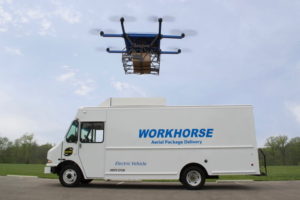
How is this possible? “The unique, patented HorseFly system complies with current FAA safety regulations for drone package delivery,” says the release. “Currently, each package is delivered within the delivery driver’s line of sight.”
Here’s how it works: customers opt-in to accept packages through an app, which “is designed to seamlessly integrate with existing online e-commerce platforms,” says the release, although which systems were not specified.
Then the Workhorse electric delivery truck – integrated with the HorseFly UAV Delivery System – drives to your house. At that point, says Workhorse:
-
The truck delivery driver loads the package and launches the HorseFly drone
-
The HorseFly drone autonomously launches from the roof of the delivery truck, gains altitude and proceeds to the delivery location, monitoring by a centralized Horsefly control center. The consumer can also monitor the progress of their package delivery through their downloaded app
-
At the delivery location, which the consumer can choose on the app by touching the point on a map, the drone autonomously descends and the package is released. The consumer can opt-in to receive a photograph and confirmation of their delivery.
-
The HorseFly drone returns to the delivery truck at a planned stop and autonomously redocks and recharges for its next delivery.
Here’s what it looks like, in a video produced during UPS’ test of the system.
Why Bother?
If the package gets most of the way by truck, why bother with a drone at all? This isn’t the type of drone delivery that can bring you a pizza in 3 minutes flat, or save a toddler’s life by getting an epi-pen to the scene of a bee sting.
The answer is simple. “The HorseFly system is designed to work with drivers to increase their efficiency and significantly lower the expense of last mile delivery.” [emphasis DRONELIFE.] “…To date, the system has been successfully tested with UPS and an undisclosed large retailer, and aims to provide significant cost savings by eliminating extra miles of driving to deliver packages.”
If drivers can increase the number of deliveries made per hour even by 2 or 3, delivery providers like UPS, FedEx or the Postal Service may save millions. It’s an incremental change – this is a long way from Amazon’s vision of warehouse to door delivery by drone – but it’s one that holds major financial significance for these providers.
What’s Standing in the Way?
Still, the Workhorse project is a major start. “Data from the pilot will provide essential insights into consumer preferences, as well as real-world evidence to support expanded use cases with the FAA,” says the release.
“We feel this is a game-changing moment to innovate the way packages are delivered for many years to come,” said Steve Burns, Workhorse CEO. “By not only reducing the expense of last mile delivery, but also providing the consumer with the ability to opt-in, visualize, and confirm their package delivery on their property, we have re-imagined home delivery.”
Miriam McNabb is the Editor-in-Chief of DRONELIFE and CEO of JobForDrones, a professional drone services marketplace, and a fascinated observer of the emerging drone industry and the regulatory environment for drones. Miriam has penned over 3,000 articles focused on the commercial drone space and is an international speaker and recognized figure in the industry. Miriam has a degree from the University of Chicago and over 20 years of experience in high tech sales and marketing for new technologies.
For drone industry consulting or writing, Email Miriam.
TWITTER:@spaldingbarker
Subscribe to DroneLife here.